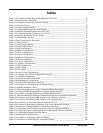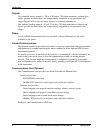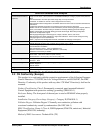
Introduction
January 2009 UDA2182 Universal Dual Analyzer Product Manual 3
1.2 Features
Standard and solution temperature compensation
Measured pH temperature is compensated in one of two ways. Electrode temperature
sensitivity is automatically compensated to display the correct pH value at temperature.
In addition, displayed pH can be optionally normalized to a solution temperature of 25°C
as determined by the current Solution Temperature Coefficient, which is expressed in
units of pH/°C with precision to the hundredths decimal place. The parameter “Solu
Temp Coeff” allows the selection of Pure Water, Ammonia, Phosphate, Morpholine, and
Custom or None (User Entry).
Measured Conductivity and Resistivity can optionally be temperature compensated to
25°C for a specific solution type. TDS and concentration are always measured based on a
specific solution type. The cell constant and measurement type determines which solution
types are available for selection.
Dissolved Oxygen accurately measures the concentration of dissolved oxygen in water.
The Analyzer energizes the probe and receives dissolved oxygen and temperature signals.
Optional salinity compensation is provided. The Analyzer provides for Air or Sample
calibration with ambient temperature and atmospheric pressure compensation.
Calculated pH
High purity water pH can be calculated from Specific and Cation conductivities to be
used as a check on in-line high purity water pH measurements.
Automatic buffer recognition
“Buffer Group” types NIST/USP, USA, or Europe determines the set of standard pH
buffer values to be used for Zero and Slope calibration by automatic buffer recognition.
Each of the available Buffer Groups is a set of 5 or 6 pH buffer standards.
Solution Temperature Compensation
For high purity water measurement you can select pre-set compensations or configure
custom values.
USP26 Alarm Capabilities
Relays can be configured to alarm on conductivity values as determined by the USP26
standards.
Computed Variables
The availability of calculated variables in the list of available sources for alarms, math
and control and for status display is determined by similarity of units of measure between
the two input boards. For example with Dual Conductivity, %Rejection/Passage,
Difference, or Ratio can be displayed and assigned to the outputs or alarms.
CO
2
concentration in ppm can be calculated from de-gassed conductivity measurement.


















